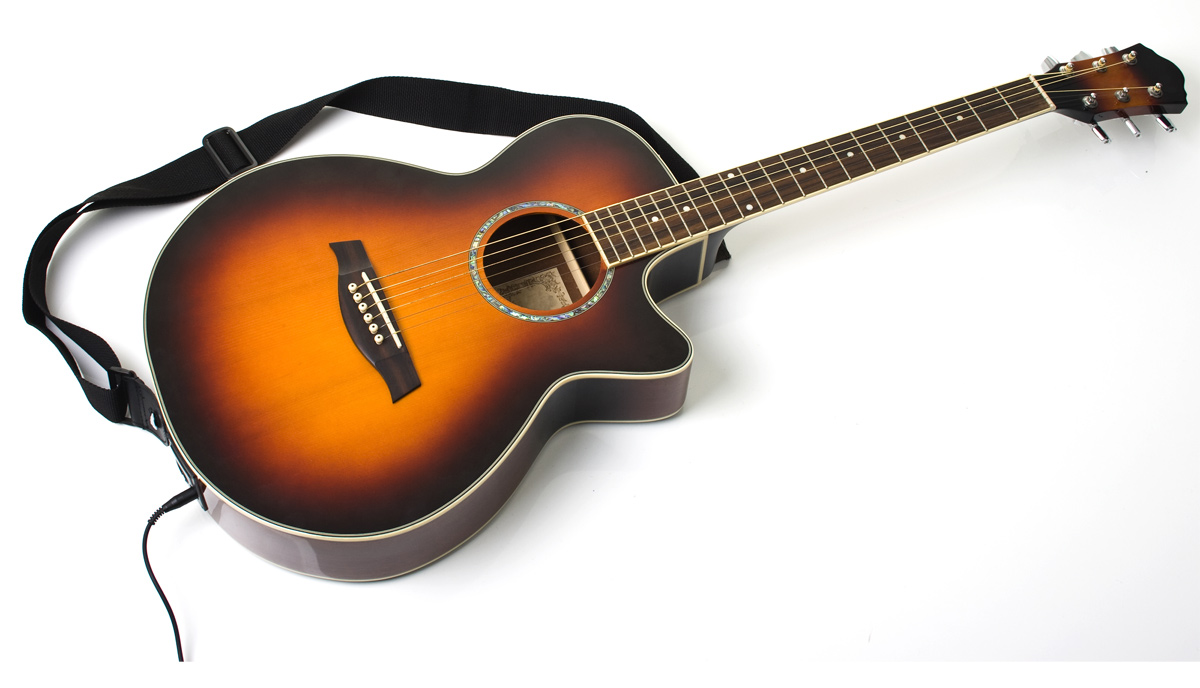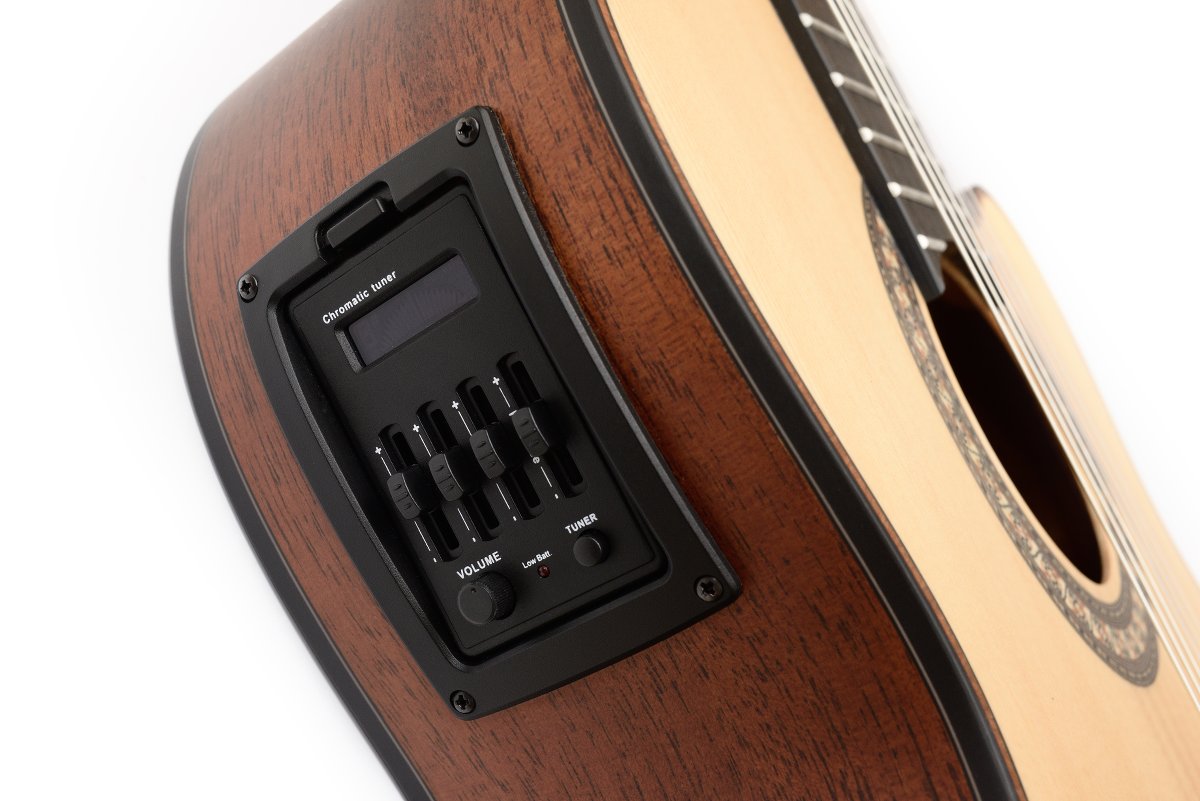What is an Electric Acoustic Guitar?
An electric acoustic guitar is any standard acoustic guitar that includes a pickup system or on-board microphone. This allows the guitar to be connected to an amplifier and therefore played through a speaker or PA system.
Why Use an Electric Acoustic Guitar?
Whether you play a classical guitar with nylon strings or a full-sized, steel-string instrument or something in between, any acoustic guitar can be fitted with a pickup system if needed. The advantage of using an electric acoustic may seem obvious; the ability to amplify your instrument without the need for a separate microphone. So why else might you consider using an electric acoustic? The answer is versatility and consistency.
With a pickup system built in to your instrument, the guitar can be plugged directly into an amplifier or mixing console. Using the guitar in this manner enables a consistent tonal output from the instrument, making it easier to control in live situations. This is very helpful if you are touring, since you might not always have adequate time to tweak the sound of a separate microphone before the show.
The use of a regular microphone would also need to factor in the microphone type (e.g., condenser, dynamic), microphone brand, polar pattern and positioning, small movements by the guitarist which affect the sound, amount of gain achievable before feedback, not to mention bleed from other acoustic sources on stage. It is certainly possible to get a great, if not better sound with a good microphone and positioning, plus a venue with a decent PA system and acoustics. However with a pickup system, you have the freedom to move around on stage, plus the sound of the guitar’s pickup output is easier to control at higher volumes, so it is much more practical.
Types of Pickup Systems
There are 3 main ways to amplify your acoustic guitar without the use of a regular microphone. The most common method is to use a piezo-electric transducer, which sits under the saddle of the strings, at the bridge. This requires an on-board preamp and power source, typically from a 9V battery. A second method is to use a regular magnetic bar-shaped pickup (similar to an electric guitar pickup) which is designed to mount under the strings, at the soundhole. This is very easy, since it requires no alteration to the guitar. The third method is to install a small electret condenser microphone inside the guitar. Manufacturers also offer combination pickup units, such as the Maton AP-5 Pro, which includes a piezo under-saddle unit and an internal mic, or the Seymour Duncan Mag Mic which combines a magnetic pickup with an internal mic. Nowadays, acoustic players will often customize their guitars to get a blend of two or even three of these pickup types, which means the guitar itself will have multiple outputs.
Issues To Be Aware Of
Guitars fitted with a preamp system require power, normally from a 9V battery. The battery doesn’t need replacing very often, but it’s a good idea to carry a spare just in case.
Secondly, the natural tone of your guitar will be compromised a little by most direct pickup systems. This is considered a small price to pay for the advantages of using one in live situations, however in the recording studio it is a common practice to mic the instrument as well as record the pickup output (through a D.I. box), giving the engineer several options for recording the best possible sound.
At higher volumes, feedback can also become an issue, regardless of whether you use a pickup or a microphone. If relying on a pickup, you can help reduce the problem by using a feedback buster, which is essentially a rubber plug that fits into the soundhole.
Choosing an Acoustic Pickup
There is no easy answer to this, as it depends on how you play, what kind of acoustic guitar you have and what kind of sound you’re after. Do some research online, including watching and listening to video demonstrations of pickups. Here’s our recommendation: if you are considering an upgrade and already own a great acoustic guitar that you have no plans on retiring, then it would be worthwhile having a pickup system fitted to that instrument. If you have an average or below-average instrument, consider purchasing an electric acoustic, as the pickups will be factory-installed, tested and optimized for that instrument. When testing an electric acoustic guitar, listen carefully – does the amplified sound clearly resemble a bigger, louder version of what is coming from the soundhole? For most people that should be the aim – a louder, but natural sound. To get you started in your research, some well known acoustic pickup manufacturers include Maton Guitars, Seymour Duncan, Fishman, B-Band and LR Baggs.
Who is LearnToPlayMusic.com
LearnToPlayMusic.com is the world’s leading music education innovator and publisher of print, eBooks, apps and online lessons.
– Continue learning with Learn To Play Music at LearnToPlayMusic.com
































I just love the acoustic guitars. I have one at home and want to buy a latest model. Thanks for sharing.
Hi Eric, It’s not an acoustic guitar, it’s an electric acoustic guitar, But yeah, I also really love an acoustic and electric acoustic guitar.
I just purchased a used Carlo Robelli. I plugged it into my amp but no sound. I checked the battery in the equalizer case. The battery light does not come on; I’m assuming it only lights up when there is a signal. Where is the actual pickup located?
Thanks.
Hi Philip, We’d suggest you get in touch with the person you purchased the guitar from for advice on this. I did a quick Google search and here is a video of a guy dropping in some Seymour Duncan pickups into a Carlo Robelli. Not sure if this is any use…
hey guys, i have an acoustic guitar, what can you say about my idea of using guitar effects from an electric guitar per se. is it ok? like, i’ll use a distortion or overdrive from my acoustic guitar (electric guitar-that-has-a-pick-up)? will that be ok or is it awkward knowing that you’re using electric guitar effects for your acoustic-electric guitar. express your opinion. i would glad to hear it from you.
josh
Hi Josh, go for it! It’s very common for acoustic guitarists to use effects both when performing live and also when recording in the studio… in addition to distortion/overdrive – try delays and chorusing as well… there are no rules apart from if it doesn’t sound good to you then don’t do it…
i love guitar
Good info. But I need to know if you can use a regular electric guitar amp for the acoustic-electric guitar. Or do I need to buy a special amp?
Hi Tammi, sorry for the delay in responding to you on this. Yes, a regular electric guitar amp will work just fine for an acoustic-electric guitar.
What I was looking for is quite different from what I’m seeing here but you know acoustic guitar don’t need amplifier or electrons to give audible sound while electric guitars make use of electrons or amplifier before they produce sound…. Now my question is that, is there a guitar that can at the same time perform both electric and acoustic?
Hi Timothy, the above article is all about acoustic guitars that can also be plugged in and used with an amplifier or for recording. They are actually very common these days.
I have a lot of buzzing while playing. Why is this?
Hi Jordan, the buzzing is most commonly caused by your left-hand fingers (assuming you’re a right-handed guitarist) not pushing down the strings of the notes / chords you are playing close enough to the frets. All notes must be fretted with the tips of the
fingers and positioned as close as practical to the frets that run across the fretboard.
We strongly recommend a good teacher and a good guitar method book at these early stages of your learning to ensure you build on good technique and get the results you want sooner.
Acoustic guitars that have built-in electronics to increase sound amplification. By appearance, acoustic-electric guitars are similar to acoustic guitars except it has a pickup installed in the bridge.
hi, I called an online store (jumia) to get an electro-acoustic guitar of which I found one and I was given an option to get one with a built-in preamp but I really don’t like design of the one with a preamp and I am clueless if all electric acoustic guitars have built-in preamp and which of them would be better to choose from (regardless of the design)
Hi Israel, A pre-amp works to amplify the sound of you guitar at the source (i.e. inside the guitar) – so that the signal then sent down the cable is stronger and clearer. If you are planning on plugging your guitar into an amplifier or a recording system then having a pre-amp will greatly improve the sound you can get. Hope this helps!
I get asked a lot what is an acoustic electric guitar so I show them the one I play.
Do I need an amp to play it